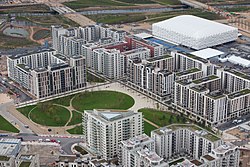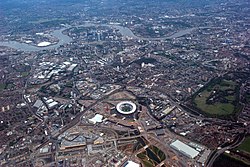East Village, Stratford
| East Village | |
| Essex | |
|---|---|
 Olympic and Paralympic Village, April 2012 | |
| Location | |
| Grid reference: | TQ385845 |
| Location: | 51°32’51"N, 0°-0’35"W |
| Data | |
| Post town: | London |
| Postcode: | E20 |
| Dialling code: | 020 |
| Local Government | |
| Council: | Newham |
| Parliamentary constituency: |
West Ham |
East Village is a district of Stratford, Essex which was built as part of the 2012 Summer Olympics. It was designed and built as the Olympic Village within the Olympic Park but so that after the Games it would be converted into the new district to be named East Village.
Design and background
As part of the regeneration programme within the bid for the 2012 Summer Olympics, the Olympic Village design that will house the athletes was based in reusing the buildings after the games as a new residential district for Stratford.
A design proposal by Lend Lease Project Management & Construction was taken forward by the Government, which covered financing and construction of both the Olympic Village and part of the London Olympics Media Centre, to provide both accommodation for 24,000 athletes, and afterwards provide a mix of low cost and private residential housing, within a community that would comprise offices, shops, schools and a health centre.
Lend Lease's professional team were briefed to design a village-garden type district to fit in with the wider urban park vision of the Olympic Park legacy, emulating the classical Victorian architecture layout of Maida Vale and other parts of Victorian Middlesex.[1] The plan provided for 11 residential plots, each made up of 5 to 7 blocks, built around communal squares and courtyards, with water features accentuating the closeness of the River Lea.[1]
The wider community is planned with wide vistas filled with gardens, parks and communal areas, within which are to be housed a school, a health clinic and shops.[1]
Pictures
History of development
The whole Olympic Park site was proposed to be secured under a Compulsory Purchase Order (CPO) by the London Development Agency. In late 2005, a row broke out between then Mayor of London and the local Council and Westfield Group over the use of the legal instrument; the site for the Olympic Village was to be next to Westfield's £4 billon development of Stratford City and to ensure access the CPO was blithely extended over all of Stratford City. In November 2005, an agreement was made where by the CPO over the Westfield site was removed, subject to agreed access provisions to the Olympic Village.[2]
In light of the 2008 financial crisis, Lend Lease found difficulties in raising funds for the construction of the village on the commercial markets, the single largest project in the 2012 Summer Olympic scheme[3] and so the greater part of the required sum had to be underwritten by the Government in order to get it done.
Up until this point, the proposed site had been a mix of former industrial buildings and contaminated land. The proposed site for the village provided two living camp sites for Irish Travellers, one on Clays Lane, Newham, and a second on Waterden Crescent, Hackney. The final part of the Olympic CPO covering the village site, secured in December 2006, was unsuccessfully challenged by the travellers in the High Court in May 2007.[4]
It was found during the development that no provision had been made in quoted budgets for valued added tax, and no thought give to the clearance of unexploded bombs remaining from the heavy bombardment the area had received during the Second World War.
Olympic and Paralympic village
For summer 2012, the first use for the blocks will be as the Olympic Village for the 2012 Summer Olympics. Taking the original design, the architects added temporary partitioning to create "hotel" style apartments catering for:[1]
- 3,300 apartments: each will have a TV, internet access, and a private courtyard
- 17,320 beds: providing each athlete adequate floor space
In addition, the developers added two temporary buildings:
- Food hall capable of catering for 5,500 athletes at a time
- Entertainment hall providing games and communcal rest space, plus a non-alcoholic bar
- A plaza for athletes to meet friends and family.
East Village

On conclusion of the games, the site will create a new residential quarter to be known as East Village.[1] This is intended to create 2,818 new homes, including 1,379 affordable homes and houses, for sale and rent.
Temporary partions installed during the games will be removed to create a range of one to five bed homes, ranging from apartments to townhouses. The hotel style designed rooms will also be converted to include kitchens. The majority of the 1,439 private homes are to be let on a rental basis, instead of being sold, with the ownership remaining with Delancey/Qatari Diar. This will create the first private sector residential fund of over 1,000 homes in the United Kingdom to be owned and directly managed as an investment.[5]
In addition, the developers will create new parklands and additional transport links, and add:
- Chobham Academy: a new education campus with 1,800 places for students aged 3–19. During the Olympics the school building will be used as the main base for organising and managing teams. Rebuilt after the games, it will open in September 2013 as Chobham Academy, home to an education campus comprising: a nursery; [primary and secondary schools; an adult learning facility; a community arts complex.[6]
- Health centre: for residents of East Village and the surrounding areas
How the new village develops socially and its appearance in reality after settling in remains to be seen.
Outside links
| ("Wikimedia Commons" has material about Olympic Village) |
References
- ↑ 1.0 1.1 1.2 1.3 1.4 Rowan Moore (8 January 2012). "Olympic Village – review". The Observer. http://www.guardian.co.uk/artanddesign/2012/jan/08/athletes-village-olympics-2012-architecture. Retrieved 27 July 2012.
- ↑ "Deal settles 2012 site land row". BBC News. 21 November 2005. http://news.bbc.co.uk/1/hi/england/london/4440922.stm. Retrieved 27 July 2012.
- ↑ London 2012 Games village deal seen by year-end Reuters Accessed 8 October 2008
- ↑ "Gypsies lose Olympic site battle". BBC News. 3 May 2007. http://news.bbc.co.uk/1/hi/england/london/6620003.stm. Retrieved 27 July 2012.
- ↑ "London Olympics Village Investor". e-architect.co.uk. 15 August 2011. http://www.e-architect.co.uk/london/london_olympics_village.htm. Retrieved 27 July 2012.
- ↑ "Olympic school gets the go ahead". BBC News. 3 April 2009. http://news.bbc.co.uk/1/hi/england/london/7981875.stm. Retrieved 27 July 2012.





